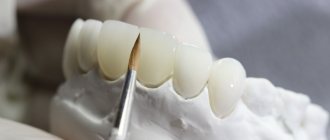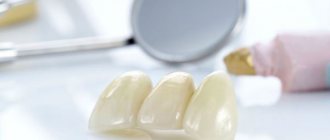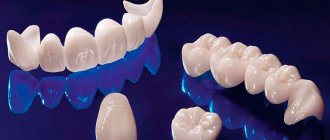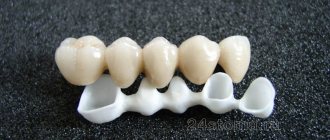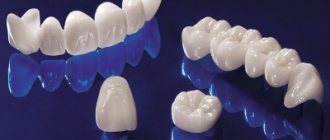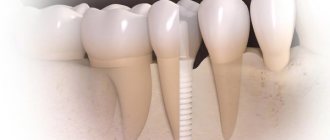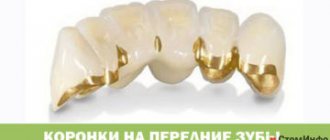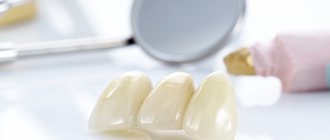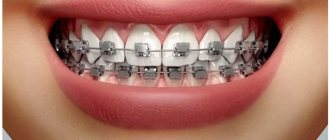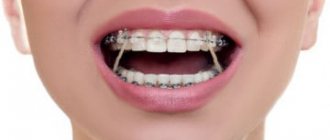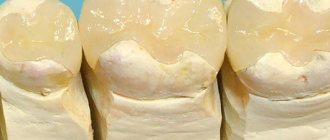Orthopedists at the Department of Dentistry of the multidisciplinary clinic CELT widely use in their work "e.max" crowns
, which today are deservedly considered one of the best. Why “e.max”? Being orthopedic products that are visually indistinguishable from natural teeth, ceramic crowns have become a real breakthrough in aesthetic dentistry.
However, they have a serious drawback: their strength characteristics are not good enough. German specialists managed to solve the problem and developed a unique material for their manufacture: press ceramics based on lithium disilicate. It has proven to be effective as it allows our specialists to achieve not only great aesthetics, but also excellent fit and functionality along with a high level of durability. You can find out the price of “e.max” crowns at the CELT clinic in this section of our website by going to the “Prices and Services” tab, or by calling us at the number listed on the website.
Dentist consultation - 500 rub.
Ceramic crown “E-MAX” - RUB 19,800.
At CELT you can get advice from a dental specialist.
- The cost of an orthopedic consultation is 500
Make an appointment
Features of e.max crowns
The production of ceramic crowns “e.max” is carried out using modern technology from a biocompatible material based on lithium disilicate. It has a special formula that includes a smaller amount of glass-like filler and the presence of lucite microparticles. The maximum strength of the material is achieved due to their minimal dimensions compared to other masses. As strong as metal, e.max all-ceramic crowns
have excellent aesthetic characteristics. They are ideal for prosthetics of the anterior teeth included in the smile zone, and are used in cases where the use of metal-ceramic dentures is contraindicated.
Pressed ceramics
Tweet Pressed ceramics or press ceramics is a type of microprosthetics that uses pressed ceramic mass and is used to make inlays , onlays for teeth , veneers and crowns .
So why are these metal-free crowns good?
This is what we will try to figure out. Moreover, their very advantage comes from the name.
1. Lightness. Compared to other permanent types of crowns, a metal-free ceramic crown is the lightest. What if there is more than one crown in the mouth? The lower jaw, of course, will not sag from the weight of the metal ceramics, but still... the difference is noticeable.
2. Durability. Thanks to pressing, the strength of the ceramic has greatly increased; now it no longer needs a metal cap as a frame. Imagine two reams of paper, one of which is pressed, which one is stronger than the one that breaks?
3. Color rendition. The color of a tooth covered with a press ceramic crown is deeper and richer. It will definitely be difficult for even an experienced specialist to determine whether it is a real tooth or an artificial crown, not to mention the people around you. In short, it is better to see once than to hear constantly. The color is so rich that words cannot describe it.
4. Metal-free crowns price. Yes, and I didn’t make a mistake. Please do not compare with metal-ceramic crowns, these are completely different weight categories. But when compared in the metal-free category, in particular with zirconium dioxide, press ceramics will come out the winner.
5. Non-invasive. To process a tooth under a ceramic press, it is necessary to grind less hard tooth tissue than for other permanent structures. The explanation is quite simple - the thickness of the crown, which we will put on the ground tooth. The more of our own hard tooth tissues we preserve, the longer it will last.
6. Versatility. Not only new crowns are made from press ceramics, but also inlays, onlays for teeth and attention - ceramic veneers .
7. Vitality. Thanks to the gentle treatment of the hard tissues of the tooth, there is no rule for depulping it. The tooth can be left alive, with the correct protocol for its preparation in order to avoid overheating of the pulp, and therefore, a living tooth will last much longer than a dead one.
8. Manufacturing. Easier and faster than other types of crowns.
And these are not all the advantages...
Among the negative aspects, it is necessary to note the impossibility of manufacturing long-term bridges and in the lateral section.
An example of work from press ceramics E MAX
Press ceramics
Pressed ceramics
metal-free ceramics
make an appointment for consultation and treatment with Dr. V.S. Fedotov directly on the website in the “make an appointment” section.
Functionality and reliability:
- The strength of ceramics has been confirmed by years of clinical use and is about 500 MPa. This allows you to create crowns with a minimum thickness (1 mm), which, in turn, requires less grinding of the tooth;
- A sufficient margin of safety allows the use of dentures made of pressed ceramics to restore teeth of all types, including chewing teeth;
- Imax crowns
have a service life exceeding fifteen years. This period is the longest among analogues; - Pressed ceramics "e.max" is a biocompatible hypoallergenic material that will not cause an allergic reaction or discomfort.
Manufacturing methods
In the manufacture of metal-free Emax crowns, two methods are used - pressing and milling.
Pressing method (e.maxPress crown)
After taking an impression and wax modeling, the structures are sent to a special oven, where they are exposed to pressure and temperature. After this, depending on the type of restoration and the specific clinical case, additional veneering, staining or glazing of the finished product occurs.
One of the most advanced types of E Max pressed ceramics is IPS e.maxPressMulti, or polychrome ceramics, which has a gradient of color and transparency, due to which it perfectly imitates the transitions to the incisal edge and lateral surfaces. It is important that the e.maxPressMulti pressed ceramic crown is completely monolithic and does not require additional veneering.
Crowns can also be made with high opacity for placement on discolored teeth or on titanium abutments after implantation.
Crown manufacturing process: blank in a milling machine
3D milling (IPS e.max CAD crowns)
This is an almost completely automated production. Glass-ceramic blocks are processed under the control of a CAD/CAM system and produced on a special milling machine. Before this, the patient undergoes an intraoral scan. The obtained data is processed by a computer program, which generates a 3D projection and sets parameters for the future prosthesis. The technology virtually eliminates errors in production, and the finished product has a large margin of safety (more than 500 MPa). Several types of materials are used in production, which allows achieving high functional and aesthetic performance.
Aesthetics
Speaking about “e.max” ceramics, it is impossible not to place special emphasis on the aesthetic characteristics of this material. By looking at the photo of e.max crowns, you will see how accurately they imitate natural teeth. Thanks to the original technology developed by Ivoclar Vivadent specialists, our prosthodontists are able to adjust the color and level of transparency of the denture, thus achieving a natural appearance of the restoration, regardless of the color of the prepared tooth. With all this, metal-free “e.max” crowns
will cost less than their zirconium dioxide counterparts.
What options can you choose?
E.max crowns are made in two ways:
- Pressing. When the impressions are taken and the wax model is made, a prosthesis is made. The workpiece is placed in a special oven, where it is under pressure for a certain time. Then, taking into account the characteristics of the clinical situation and the type of restoration being performed, additional veneering, glazing or painting is carried out.
- Milling. It is an automated process. Ceramic blanks are produced under CAD/CAM control on a milling machine. The client first undergoes a scanning procedure. Information about the characteristics of the jaw obtained during this procedure is loaded into a computer and immediately processed. As a result, the program models a tooth that is ideal for the customer. Even the slightest errors when using milling are excluded.
Why are press ceramics better than ceramics?
Many patients are interested in the question of why we recommend press ceramic crowns to our patients rather than conventional ceramics. In addition to the excellent strength characteristics of these orthopedic structures, the fact is that the “e.max” technology has proven itself through repeated use in practice. The prosthesis is fixed with special cement, the formula of which allows it to be connected at the microscopic level to the tissue of the supporting tooth.
Thus, it becomes integral with the rest of it, providing the desired aesthetics and functionality. How long does it take to produce e.max crowns? The production time for press ceramic crowns depends on the clinical case and the condition of the patient’s teeth. On average, they are about two to two and a half weeks. We cooperate with trusted dental laboratories in Moscow and guarantee our patients a high quality level of production of Imax crowns.
Ceramic inlays made using E-MAX technology
Teeth cope with extreme stress throughout their lives, which inevitably leads to their destruction. If the tooth is damaged by more than 50%, the patient is faced with the question of what to do in this case. Filling material will not cope with the problem; the use of crowns is not always advisable. More recently, a new unique tool has appeared that allows you to effectively restore the functional characteristics and structure of the dentition. The missing parts of the teeth are filled in using special inlays. Their main difference from fillings is that the manufacturing process takes place in a laboratory using specially created impressions. The inlays are made of ceramic, which ensures absolute aesthetics. After installing the inlays, it is almost impossible to determine where the natural tooth is and where its modified part is. Such inlays are significantly superior to fillings in all physical characteristics, and especially in service life. The latest research in aesthetic dentistry includes the use of metal-free ceramics E-max.
Main features of E-max ceramic inlays
A dental inlay is a miniature-sized prosthesis for the restoration of hard dental tissues and restoration of their anatomical shape, as well as to give an aesthetic appearance. The peculiarity of inlays made using E-max technology is that the patient receives a result that will not darken or fade over the years, and the material will retain all its physical characteristics. Ceramics are as close as possible in color to natural enamel and are highly durable. Thanks to modern technologies, the size of the gaps between natural dentin and the artificial part does not exceed several microns.
Advantages of E-max tabs
- Durability - at least 10 years of guaranteed service life of the tab, but practice shows that it is much longer;
- Degree of fit - the inlay fits perfectly to the teeth, as it is made in the laboratory using high-tech technologies;
- No shrinkage or deformation – during manufacturing and subsequent installation, the inserts do not change in size or become deformed. The main cause of secondary caries can be the entry of bacteria into the cracks between the filling material and dentin; due to the shrinkage process of the filling, problems of this nature are excluded with a ceramic inlay.
- Aesthetic appearance – the selection of the shade of the inlay is carried out individually for each patient and is identical to the natural color of tooth enamel. The border between the inlay and the tooth is practically not identifiable.
Highly qualified specialists of the IntelPlus clinic in Vidnoye have extensive experience in the manufacture and installation of E-max ceramic inserts.
How much are?
While the average cost of “e.max” crowns in Moscow is about 20 thousand, by contacting us you can save a little. The price of one design in CELT dentistry starts from 18 thousand rubles - and it is quite justified when it comes to metal-free “e.max” crowns! Once you choose them, make sure that the installation is carried out at a decent professional level. Savings in this case will cost much more!
Please note: we carry out work only after full agreement with the patient. This is the key to maximum comfort and satisfaction of individual requirements.
Advantages and disadvantages
Let's look at why Emax onlays are better than other ceramic veneers and why you should choose them:
- Aesthetics and naturalness : the color scale allows you to choose not only the shade, but also the degree of transparency of the material. This allows you to match the colors of Emax veneers as accurately as possible to the color of your remaining teeth.
- Highest strength : depending on the technique, E-max veneers can withstand pressures from 470 MPa (IPS Impress technology) to 530 MPa (E-max IPS Impress CAD technology).
- Minimal preparation : to install the plate, you need to remove no more than 0.3 mm of enamel.
- Perfect fit : computer modeling of E-max veneers using the CAD technique allows you to achieve an exact fit to the neck of the tooth without cracks or gaps. This allows you to avoid darkening and caries under the structure in the future.
- The ability to see the final result of the work before it begins : computer modeling using CAD/CAM technology allows the patient to see his smile on the screen before and after the installation of microprostheses, as well as take part in their modeling, adjust the shape and color as desired.
- Absolute color fastness : due to the absence of pores, the German onlay does not absorb dyes from food, does not turn yellow or darken, as composite photopolymer veneers do.
- The approximate service life of E-max veneers is 10 years or more.
The only significant drawback is the price of Emax veneers, which not everyone can afford to pay. But, if you consider that German microprostheses will last twice as long as conventional ones, which have a shelf life of no more than 5 years, then it is not so expensive. In addition, due to the absence of chips and breakages during wear, the price of Emax ceramic veneers may be even more profitable than the cost of onlays made from conventional ceramics.
Indications and contraindications
IPS E-max veneers solve the same aesthetic problems as other similar designs:
- diastema and wide spaces between the front teeth;
- slight irregularities in the anterior group of teeth (protrusion or rotation around the axis of one or two teeth), in this case Emax ceramic veneers replace braces;
- unaesthetic color of the front teeth due to numerous restorations, hypoplasia or fluorosis;
- erosions and wedge-shaped defects of the necks of teeth;
- unsatisfactory shape or size of incisors and canines;
- extensive fillings and restorations on the front teeth, which cannot withstand the chewing load and periodically chip.
Judging by the reviews of E-max veneers, they work well on the upper front teeth, solving several problems at the same time. Some patients with increased aesthetic requirements make additional plates for their lower teeth. It is also possible to fix ceramic plates on the lateral teeth, but in this case, a dental inlay or crown on zirconium dioxide will last longer, because they have a large area.
IMPORTANT : Usually, onlays are fixed on 6-10 upper teeth at once, but this is not necessary. It is possible to install two or three units only on problem teeth.
The installation of E-max ceramic orthopedic veneers is contraindicated only in cases of direct bite, the presence of bruxism (teeth grinding) and the loss of a large number of lateral teeth. In the latter case, you must first do prosthetics, and only then read reviews of Emax Press veneers and decide on the choice of design for the front teeth.
Comparison with crowns made from other materials
Pressed ceramics is an innovative material that is superior to other materials in a number of characteristics. Thus, metal ceramics are not able to provide the transparency necessary for a natural appearance. Moreover: over time, the ceramic coating will begin to come off, “exposing” the metal. In contrast, solid ceramics look great, which is why crowns made from it are placed on the front teeth. However, unlike “e.max”, it is not strong enough and is unable to withstand chewing loads! Zirconium dioxide is the only material that is stronger than pressed ceramics, which is why crowns are used to restore chewing teeth. It is well suited for the manufacture of prostheses on implants, does not cause an allergic reaction, but its price is the same as that of “e.max”.
What are metal-free dental crowns?
As the name suggests, these are structures that do not contain metal. Unlike metal-ceramics, which includes two layers (a metal frame and a ceramic veneer), metal-free dentures consist either entirely of ceramics (all-ceramic) or of ceramics on a zirconium frame.
What is the difference between metal-ceramic and metal-free structures?
The main differences between a metal-ceramic crown and all-ceramics are:
- thickness of the prosthesis;
- Possibility of installation on living teeth;
- strength;
- aesthetic qualities;
- risk of allergies;
- price.
The thickness of metal ceramics is 1.1-1.5 mm, while an all-ceramic product has a thickness of 0.4 mm . Accordingly, the amount of preparation (grinding down) of enamel for these dentures will also be different. Due to massive grinding for metal-ceramics, the teeth are usually depulped (nerves are removed) so that later they do not hurt under the prosthesis due to traumatic grinding.
There is no need to remove nerves for a metal-free ceramic dental crown . Teeth remain alive under the structure and last much longer than pulpless ones, because continue to receive nutrients from the blood vessels of the pulp.
Due to the absence of a layer of gray metal, metal-free crowns on the front teeth look much better than metal-ceramic ones . The light refraction of all-ceramic structures does not differ from that of native tooth enamel, due to which they are often indistinguishable from natural teeth.
The absence of metal in the mouth also reduces the risk of allergies and galvanosis (the interaction of one metal with another). The only thing that all-ceramic prostheses are inferior to is their high price and slightly less strength.
But, if you need maximum aesthetics and a gentle approach, making an all-ceramic structure is the best choice.
